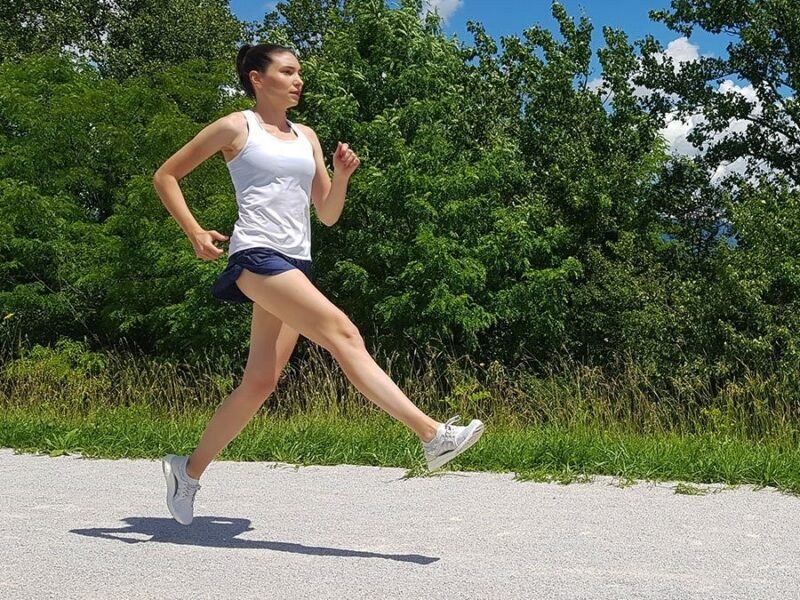How To Properly Do Straight Leg Bounds? (Step-by-Step)
Improve your running technique using a simple straight leg bounds drill.
In this article, I will explain how to properly do straight leg bounds and I will answer the frequently asked questions.
What are straight leg bounds?
Straight leg bounds are a running drill used for warming up and for improving running technique. It teaches to actively attack the ground with feet and to develop proper contact, not allowing overstriding. It also improves arm-to-leg coordination.
How to do straight leg bounds properly?
- Begin by standing with your feet hip-distance apart, look straight ahead, and keep your upper body straight.
- Stretch your right leg forward, while bending your knee as little as possible.
- Pull your right leg below your center of mass and emphasize the explosive contact of the ball of your foot with the ground, while stretching your left leg forward.
- Continue alternating sides and moving forward.
Your arms should follow your leg movements, as they do when you are running.
As you are doing the straight leg bounds your foot should be bent towards your shin (dorsiflexion).
Tips for performing straight leg bounds properly
- Mind your posture. Keep your body straight; do not bend forward or backward.
- Move your legs similar to scissors as you move forward.
- Focus on quickly pulling the leg below you, not on stretching it forward.
- The foot must not be bent away from the body, in plantar flexion, because you will not be able to hit the ground with force.
- Do not forget to move your arms. Swing the arm opposite the raised leg.
It is important to focus on the proper execution of straight-leg bounds.
Not doing straight leg bounds properly will ruin your running technique and increase the risk of injury as a result.
If you are not sure whether you are doing straight leg bounds properly, it is advisable to do it while being watched by the coach.
If that is not an option, then ask another runner to observe you or record yourself so that you can see whether you are performing the exercise properly.
Read more: Top 8 Running Drills To Improve Your Form [Video]
What muscles do straight leg bounds target?
Straight leg bounds activate the hip flexor muscles by raising your shins so they can produce more strength and explosiveness, allowing you to run faster.
Straight leg bounds target the following muscles:
- Glutes
- Hip flexors
- Hamstring
- Calf muscles
- Quadriceps
- Tibialis anterior
Straight leg bounds benefits
Besides being part of a warm-up routine before more intensive training or races, straight leg bounds also have other benefits.
1. Improves running technique
Straight leg bounds are used to activate your shins and hip extensor muscles, used during faster runs.
Straight leg bounds also teach you the proper foot position during a run.
The foot should be bent towards the shin, in the position of dorsiflexion. Dorsiflexion enables the activation of calf muscles.
As you hit the ground the calf muscles will contract, allowing you to hit the ground with more force.
2. Improves neuromuscular effectiveness
Straight leg bounds improve communication between nerves and muscles by quickening nerve impulses that send signals to muscle fibers.
As a result, your muscles will have better coordination in more intensive training or race.

3. Strengthens and stretches hip flexor muscles
Hip flexor muscles consist of several muscles that allow you to stretch your legs and bend your upper body forward.
Straight leg bounds strengthen and stretch your hip flexor muscles at the same time.
4. Reduces contact with the ground
Straight leg bounds teach you to run on the balls of your feet so that you can develop the strength necessary to push off the ground with more force.
Running on the balls of your feet reduces the time spent in contact with the ground, which makes your run faster.
In 2007 scientists from the Ryukoku University in Japan set up a high-tech camera on the 15-kilometer-section of the half marathon and used it to record 283 runners.
Research has shown that an average midfoot striker spends 183 milliseconds in contact with the ground, while an average heel striker spends 200 milliseconds in contact with the ground.
A shorter time of contact results in a faster run and higher running economy.
5. Increases cadence
Straight leg bounds teach you not to overstride and to avoid running over your heels.
It helps you develop proper running technique, teaching you to hit the ground right below you.
This way you keep the momentum and avoid the slowdown while increasing the cadence (number of steps in a minute).
Research has shown that increasing cadence by 10% reduces the stress on your knees by 5%. This reduces the risk of usual runner injuries, such as hip or knee injuries.
How and when to include straight leg bounds in your training?
Straight leg bound is a running drill used in warm-up routines before more intensive training or races.
Also, you can use it after an easy jog, when you are not as tired, so you can focus on the proper execution of the exercise.
Straight leg bounds can be done moving forward 20 to 40 meters and then resting as you walk back to your starting position.
Example of a warm-up routine before interval training (12 x 400m)
1. Easy jogging (10 minutes)
2. Mobility exercises and dynamic stretches (7 minutes)
3. Running drills – 2 x 30m ankling, 2 x 30m high knees, 2 x 30m straight leg bounds, 2 x 30m butt kicks
4. Strides – 3 x 60m
Read more: Warm-up Before Running [Ultimate Guide]

Matea Matošević
Hi, I’m Matea! I’m an Olympic Marathon Runner, founder, and writer behind OLYRUN.com. On this site, I provide help in the form of my knowledge and experience to all who love running and active living. Read more…

